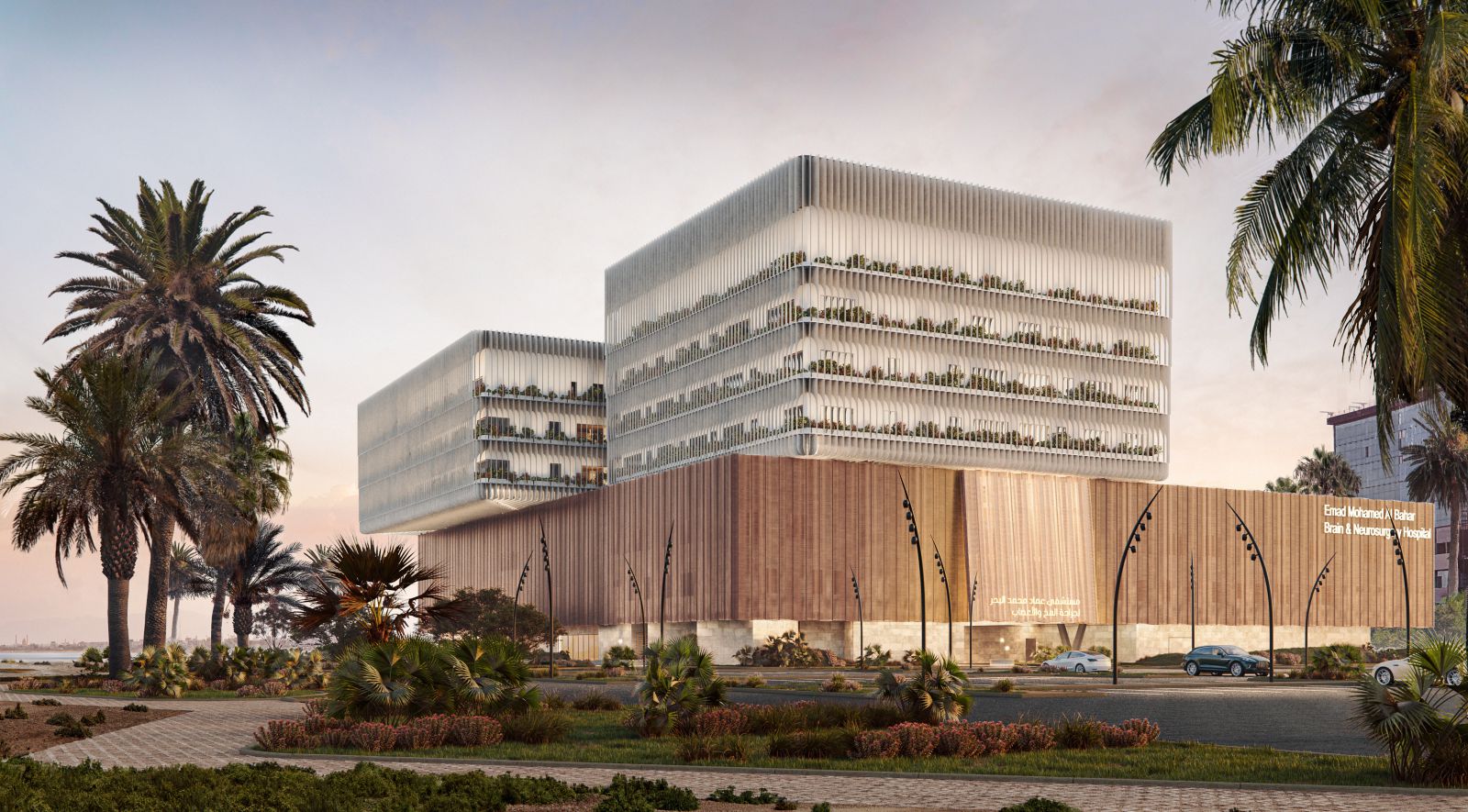The SJM Kidney Transplant & EMB Neurosurgery Hospitals in Kuwait are one of our most recent projects. This commission, already at an advanced design stage, has taken as its starting point a programme we had already worked with for a different location in Kuwait City, the Kidney Transplant Hospital.
It now moves to a new site on the waterfront, and is expanded with a hospital dedicated to neurological interventions. The two centers are connected to the mother hospital, Al-Sabah Hospital, which is located in the next block.

The project has been approached with the simultaneous objectives of making the organisation of the complex programme efficient and creating an experience of well-being and warmth for visitors. Four strategies have been put into use to achieve this.
Firstly, nature has been conceived as a form of healing. Secondly, the gaze towards the sea views has been considered as a stimulus for well-being. In addition, public space has been taken into account as a starting point for the therapeutic process. And finally, natural light has been used as a signposting element.

In addition, the façades have been treated in such a way as to create a link with the geographical and cultural context. The programme of the neurosurgery hospital and of the kidney hospital are placed compactly on the site. All functions, except for the patient rooms, are planned on the lower levels of the building.
The volume they form is broken on the ground floor by a large crack parallel to the sea. This crevice houses the access to each of the two centers on either side. Both entrances converge in a large space: the atrium and reception area for the two hospitals.

The vegetation and natural light are the protagonists in this space. The ground floor is designed in a fractured, ample and open way in order to welcome visitors. The first, second and third floors, however, form a clearly defined volume that floats above ground level.
Different hospital functions are located in this podium, illuminated through the façades and courtyards and connected by bridges over the atrium. Above this compact podium, the in-patient rooms are placed forming two differentiated volumes, one for each hospital. All rooms have sea views.

Perceived from the outside, the building signifies the structure of its programme through the treatment of the façades. The materials and textures are inspired by the cultural and geographic context. This connection with the local landscape creates a sense of belonging.
Two different lattices envelop the building. They are both designed in warm tones that create a feeling of softness for the metallic materials. The podium is enclosed by a mesh with Arabic reminiscences. The craftsmanship of palm weaving has inspired and guided its development. This is a contemporary mashrabiya that not only guarantees privacy, but also protects from the strong sun and glare.

At the entrances, the lattice makes the gesture of rising. Behind this metal awning, the atrium appears, full of light and vegetation. In this way, the building welcomes the patient, introducing positive sensations of well-being from the moment of arrival.
The upper volumes are enveloped in a grid of vertical slats. This second skin is inspired by the natural curves found in nature, in desert dunes and ocean waves. Its rhythmic appearance not only provides shade but also allows optimal maintenance of the façade. Source by AGi architects.

- Location: Shuwaikh Industrial, Kuwait
- Architect: AGi architects
- Main Architects: Joaquín Pérez-Goicoechea
- Project Team: Stefania Rendinelli, Nasser B. Abulhasan, Pedro Moreno, Ignacio Bergamín, Marta Lozano, Cristina Araujo, Gonzalo Yuste, Pablo Garrido, Juan Salgado
- Medical consultants: TAG
- Technical architecture: Jordán Romero
- Structural engineering: Gogaite
- MEP engineering: Argenia
- Lighting: ELBAZGILDEMONTES
- Area: 30,335 sqm
- Images: The Viz Design Company, Estudio Nod, Courtesy of AGi architects

